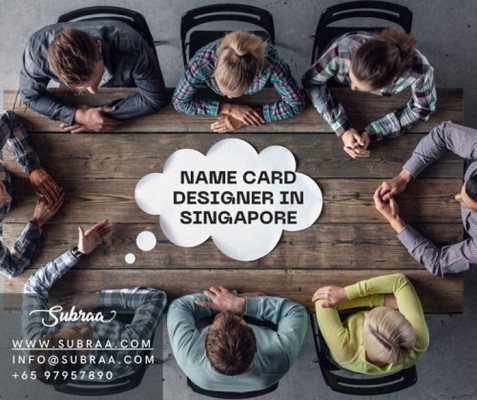Impression on Potential Customers and Business Partners — Subraa
Online marketing dominates, traditional marketing materials like name cards and flyers continue to play a crucial role in promoting businesses and attracting customers. These tangible marketing tools offer unique benefits that digital marketing channels cannot replicate, making them essential components of any comprehensive marketing strategy. 1. Name Cards: Name cards are small, portable, and versatile marketing tools that provide a personal touch to networking and brand promotion. They serve as a tangible representation of your brand identity, containing essential contact information, including your name, title, company name, phone number, email address, and website. When Name card designs are done effectively, they can leave a lasting impression on potential customers and business partners, helping to establish credibility and professionalism. Effective business card design involves careful consideration of layout, typography, color scheme, and branding elements. A well-designed Business card should reflect your brand’s identity and convey key messages clearly and concisely. Utilizing high-quality materials and finishes can also enhance the perceived value and professionalism of your business cards, making them more memorable and impactful. 2. Flyers: Flyers are versatile marketing materials that can be used to promote events, sales, products, or services to a targeted audience. Unlike digital advertisements, flyers provide a tangible and tactile experience, allowing potential customers to engage with your brand physically. They can be distributed in various locations, such as trade shows, events, local businesses, or door-to-door, to reach a wide audience effectively. Effective flyer design involves capturing attention with compelling visuals, headlines, and messaging that communicate the key benefits and value propositions of your offering. Incorporating eye-catching graphics, clear calls-to-action, and relevant information can help drive engagement and conversions. Additionally, using high-quality paper stock and printing techniques can enhance the perceived value and professionalism of your flyers, making them more likely to be retained and acted upon by recipients. In conclusion, Name cards and flyers remain essential marketing tools that offer unique benefits and advantages in today’s digital landscape. By incorporating these tangible materials into your marketing strategy, you can effectively reach and engage with your target audience, establish brand credibility, and drive business growth. Website: https://www.subraa.com/ #namecarddesign
Read more
Lasting impressions, fostering meaningful connections and promoting brand visibility — Subraa
Online networking and social media platforms dominate the business landscape, the humble namecard design remains a timeless and essential marketing tool. Despite the prevalence of digital communication, business cards continue to play a crucial role in making lasting impressions, fostering meaningful connections, and promoting brand visibility. Business cards serve as tangible representations of a company or individual, encapsulating their brand identity, contact information, and value proposition in a compact and portable format. Whether exchanged during formal meetings, networking events, or chance encounters, a well-designed business card instantly conveys professionalism, credibility, and attention to detail. Moreover, business cards provide a convenient and memorable way for recipients to recall important details about a person or business. With just a quick glance, potential clients, partners, or customers can access key information such as phone numbers, email addresses, and website URLs, making it easier to follow up and initiate further communication. In addition to their practical utility, business cards offer endless opportunities for creative expression and brand differentiation. From choosing unique paper stocks and finishes to incorporating eye-catching designs and typography, businesses can tailor their business cards design to reflect their personality, values, and aesthetic preferences. A well-designed business card not only leaves a lasting impression but also serves as a tangible representation of a brand’s identity and professionalism. Furthermore, business cards serve as valuable marketing collateral that can help businesses expand their reach and attract new opportunities. Whether distributed at trade shows, conferences, or local events, business cards act as miniature marketing materials that introduce a brand to potential customers and collaborators. In an increasingly competitive marketplace, having a well-designed and strategically crafted business card can make all the difference in capturing attention and making meaningful connections. In conclusion, name card remain a vital tool in the modern business world, offering a tangible and impactful way to promote brands, facilitate networking, and leave a lasting impression. By investing in well-designed and professionally printed namecard design, businesses can enhance their credibility, visibility, and overall marketing effectiveness. Take a Look: https://www.subraa.com/ #namecarddesign
Read more
Ensure a polished and professional appearance — Subraa
Name card design can make a lasting impression and serve as a powerful marketing tool. Here are some tips and strategies to ensure the success of your business card design: 1. Keep it Simple: When it comes to business card design, less is often more. Avoid cluttering your card with excessive text or graphics. Instead, focus on conveying essential information such as your name, job title, contact details, and company logo in a clean and visually appealing layout. 2. Choose the Right Typography: Selecting the appropriate font styles and sizes is crucial for readability and visual appeal. Opt for clear, legible fonts that reflect your brand’s personality and complement the overall design of your card. Experiment with font weights, sizes, and spacing to create hierarchy and emphasis. 3. Pay Attention to Color: Color plays a significant role in branding and can evoke specific emotions or associations. Choose colors that align with your brand identity and resonate with your target audience. Consider using contrasting colors for text and background to ensure readability and visual impact. 4. Incorporate High-Quality Imagery: Including images or graphics can enhance the visual appeal of your business card design and reinforce your brand identity. Use high-resolution images or vector graphics to maintain clarity and sharpness, and ensure they are relevant to your business or industry. 5. Mind the Bleed and Margin: To prevent any design elements from getting cut off during printing, ensure your design includes a bleed area and sufficient margins. The bleed extends beyond the final trim size, while the margin provides space between the edge of the card and important design elements. 6. Utilize Special Finishes: Consider incorporating special finishes such as embossing, foil stamping, or spot UV coating to add texture, shine, and sophistication to your business card. These finishing touches can make your card stand out and leave a memorable impression on recipients. 7. Proofread and Review: Before finalizing your design, carefully proofread all text for spelling and grammatical errors. Additionally, review the layout, alignment, and overall aesthetics to ensure a polished and professional appearance. In conclusion, successful name card design requires attention to detail, creativity, and a thorough understanding of your brand identity and target audience. By following these tips and strategies, you can create a business card that effectively represents your brand, makes a memorable impression, and leaves a positive impact on potential clients and contacts. Know more: https://www.subraa.com/ #namecarddesign
Read more
Leave a memorable impression to showcase — Subraa
One networking platforms abound, one might question the relevance of physical name cards. However, the importance of name card design extends far beyond mere contact information — they play a vital role in making a lasting impression and facilitating meaningful connections in business settings. First and foremost, name cards serve as a convenient and efficient way to exchange contact information during face-to-face interactions. In a fast-paced business environment, where opportunities can arise unexpectedly, having a name card readily available ensures that individuals can quickly share their contact details with potential clients, partners, or colleagues. This seamless exchange of information fosters networking and lays the groundwork for future communication and collaboration. Moreover, name cards serve as a tangible representation of a brand’s identity and professionalism. A well-designed namecard reflects positively on the individual and the organization they represent, conveying a sense of credibility, reliability, and attention to detail. From the choice of typography and color scheme to the incorporation of logos and branding elements, every aspect of name card design contributes to shaping the recipient’s perception of the brand. In addition to facilitating networking and conveying professionalism, name cards also play a role in personal branding and marketing. By carefully crafting the design and content of their name cards, individuals can effectively communicate their unique value proposition and differentiate themselves from competitors. Whether it’s highlighting key skills and achievements or showcasing a distinctive visual style, name cards provide a platform for individuals to showcase their personal brand and leave a memorable impression on recipients. Furthermore, name cards serve as a tangible reminder of past interactions and connections, making it easier for individuals to follow up and stay in touch with contacts. Instead of relying solely on digital platforms or memory to recall someone’s contact information, recipients can refer to the physical name card as a reference point, strengthening the connection and fostering continued communication. In conclusion, name cards play a crucial role in modern business settings, serving as more than just a means of sharing contact information. They facilitate networking, convey professionalism, support personal branding, and serve as tangible reminders of past interactions. With thoughtful business card design and strategic use, individuals can make a lasting impression and forge meaningful connections that contribute to their professional success. Get to know: https://www.subraa.com/ #namecarddesign
Read more
Investing in Business Card is essential — Subraa
Name Card Design, commonly known as business cards, serves as a powerful tool for networking, branding, and leaving a lasting impression on potential clients or contacts. Here’s why investing in a well-designed business card is essential and its various uses. First Impression: A professionally designed business card creates an immediate positive impression of your brand or business. It reflects your professionalism and attention to detail, setting the tone for future interactions. Memorable Branding: A unique and eye-catching Name Card Design helps your brand stand out in a sea of competitors. Incorporating your logo, brand colors, and distinctive design elements reinforces brand recognition and makes your card memorable. Networking Tool: Business cards facilitate networking by providing essential contact information in a convenient format. Whether at conferences, meetings, or networking events, exchanging business cards makes it easy for potential clients or collaborators to reach out to you later. Direct Marketing: Business cards serve as a tangible marketing tool that can be distributed easily in various settings. Handing out your card to prospective clients, partners, or leads enables them to contact you when they need your products or services. Professionalism: In today’s digital age, where virtual connections are common, a physical business card adds a personal touch to your interactions. It shows that you are serious about your business and willing to invest in traditional marketing methods to connect with clients. Convenience: Namecard design provides a convenient way for people to store and retrieve your contact information. Unlike digital contacts, which can get lost in crowded email inboxes or forgotten, a tangible business card is easily accessible when needed. Versatility: Business cards design are not just for sharing contact information. They can also serve multiple purposes, such as appointment reminders, loyalty program cards, or discount vouchers, depending on your business needs. Brand Consistency: Consistent branding across all marketing materials, including business cards, reinforces your brand identity and fosters trust and credibility among your target audience. In conclusion, namecard design plays a crucial role in networking, branding, and marketing your business. By investing in a well-designed and professionally printed business card, you can make a positive first impression, enhance brand visibility, and create valuable connections that drive business growth. Know More: https://www.subraa.com/ #namecarddesign
Read more




